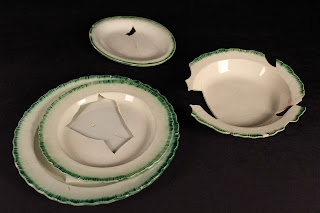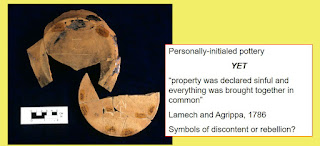The American holiday that would become known as
Thanksgiving had its origins in Europe. Many towns and villages held
celebrations to mark a plentiful harvest and blessings of the previous year.
When the first Europeans came to America in the late 16th and early
17th centuries, they brought these harvest celebration traditions
with them. Harvest celebrations and days of thanksgiving were held sporadically
in the early colonies as no formal holiday existed. The First National
Proclamation of Thanksgiving was issued by the Continental Congress from its
temporary capitol in York, Pennsylvania in 1777. Thanksgiving has been
celebrated as a national holiday since 1863 when it was designated by President
Abraham Lincoln.
Over the years since the first celebrations were held,
many types of table wares have held the Thanksgiving holiday meal. From deer
and squash on wooden bowls and pewter dishes, to turkey and mashed potatoes on
disposable plastic plates; the feast is served on the popular dishes of the
day.
From the time of the first national Thanksgiving
proclamation, the holiday meal would have been served on the fashionable table
wares of the day including creamware and pearlware. Creamware and pearlware
were fine earthenware ceramics manufactured in England from the mid-18th
century through the 1840s. Creamware is a cream-colored porous ceramic that
appears yellow or green where it pools in crevices. Pearlware appears white or
slightly blue-tinted to the eye and pools blue in crevices.
These ceramic types were produced in a large variety
of vessel forms, sizes, decorative styles, and colors, and remain as highly
popular today as they did in the decades around the turn of the 19th
century. Creamware and pearlware are found on most archaeological sites of that
time period and the State Museum of Pennsylvania collections hold many exceptional
examples of these ceramic types.
A large variety of shell-edged pearlware vessels were
recovered from Philadelphia Market Street Site 36Ph001 in the 1970s, including
different sizes and shapes of food serving dishes and serving platters. Many of
these pieces are decorated with a blue shell-edged rim pattern.
Blue
Shell Edge Pearlware Serving Dishes and Platter
In the late 18th and early 19th
centuries, holiday meals may have consisted of many courses of meats, wild game,
and seafood with accompanying vegetable and side dishes. Sauces, creams, and
gravies would have been provided to pour on top. Several blue shell-edged
pearlware gravy or cream boats are part of this collection.
Blue
Shell Edge Pearlware Gravy or Cream Boats
A table setting of the time would have consisted of
numerous wine, liquor, and drinking glasses; individual place settings of up to
24 pieces; and different size plates and bowls for each course of food. These
pearlware plates and bowls with green shell-edged rims were also recovered from
site 36Ph001.
Large creamware serving platters may have held meats
such as turkey, chicken, fish, or pork. Creamware was available in several popular
patterns. The serving platters pictured here have Feather edge and Royal edge rim
patterns.
Creamware
Serving Platters: Feather Edge Pattern (left) and Royal Edge Pattern (right)
Creamware table settings were available in the Feather
edge and Royal edge patterns, as well as in the Queens pattern, octagonal shaped
rims, and several other patterns. Queen’s pattern or Queensware was named for
its popularity with British Queen Charlotte.
Pearlware table wares with transfer-printed
decorations became popular around the turn of the 19th century.
Transfer printing involved transferring an inked design from a copper plate onto
a ceramic vessel. Early transfer print pieces were available in blue, with
later colors developing in black, brown, red, purple, and green. These pieces
often exhibit oriental scenes, pastoral landscapes, or biblical and romantic
motifs and were very popular at the time. The Head House and Commuter Tunnel
sites in Philadelphia produced many beautiful ceramics including a number of
transfer-printed pearlware vessels shown here.
Transfer-printed
Pearlware Dishes in Blue and Black. Bottom Plate Motif is a Landscape Scene
from Conway, New Hampshire
Creamware and pearlware vessels were also produced using
many other decorative techniques including handpainting, dipping (annular,
mocha, banded), sponging, luster glazing, enameling, embossing, and encrusting
(gritted). The great popularity of creamware and pearlware ceramics finally
began to die out in the mid-1800s, making way for whiteware and ironstone.
No matter how you choose to enjoy your Thanksgiving
dinner – whether on grandma’s antique china or on Styrofoam plates – we in the
Section of Archaeology wish you a terrific holiday! And should you decide you
would like to set your table with some lovely creamware or pearlware, there are
many websites where you can purchase these pieces , including this beautiful,
17-piece creamware set - https://www.1stdibs.com/furniture/dining-entertaining/dinner-plates/english-pottery-creamware-blue-enamel-shell-edge-dessert-service/id-f_897887/.
Thank you to our followers, volunteers and colleagues
who help us in our efforts to preserve the past for the future. We have much to be thankful for and hope
you’ll continue to follow our blog and visit with us in the future.
For further information, please see these sources:
History
Channel
2017 History of Thanksgiving. History Channel
website, at http://www.history.com/topics/thanksgiving/history-of-thanksgiving.
Maryland
Archaeological Conservation Lab
2002 Diagnostic Artifacts in Maryland. Jefferson
Patterson Park & Museum website, at https://www.jefpat.org/diagnostic/index.htm.
Pilgrim
Hall Museum
The
Cook’s Guide
2005 The Cooks Guide and Housekeeper’s &
Butler’s Assistant website, at http://www.thecooksguide.com/articles/dining-etiquette.html.
For more information, visit PAarchaeology.state.pa.us or the Hall of Anthropology and Archaeology at The State Museum of Pennsylvania .





















